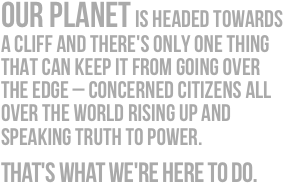By Richard Van Kampen
Sitting in the back of the first plenary meeting of the Subsidiary Body for Implementation (SBI) at the COP15 in Copenhagen, I wonder what kind of agreement, if any, will actually come out of this round of negotiations. I’m not pessimistic on the issue, however considering the progress of past negotiations under the UNFCCC, there is a significant amount of progress that needs to be made before an agreement is reached, and quite a few concessions that must be made by the developed world if that agreement will be fair, ambitious, and binding.
A major point of contention for many developed (Annex I and Annex II) countries has been their commitment under the Convention to provide financial resources that will cover the full costs of adaptation, mitigation, technology transfer and capacity-building associated of climate change in developing (Non-Annex) countries. The negotiator from Algeria summarized my opinion of the financial aspect of the negotiations pretty well while addressing the chair person of the subsidiary body this morning. He made the statement that any agreement that is reached will be pointless without sufficient financial resources, a simple yet important point to consider. While so much work has to be done in other areas of negotiations, the issue of funding could cripple any progress that is made over the next few days.
The Bolivian negotiator spoke, in his words, “candidly” yesterday comparing climate change funding to the funding of corporate bailouts that have been occurring in the United States over the past several months. In short, he put everything into perspective stating that if Washington can spend trillions of dollars within the US to bailout Wall Street, what is it to ask for several or even several hundred billion dollars in funding from all nations in the developed world.
What he said is we’re talking billions, not trillions; and this is on a global scale – and not about one country’s domestic policy. The burden to fund climate change actions does not lie solely with the United States or any one single country, it is a problem that affects every nation and will take every nation in the world to solve.
Why are the costs the major point of contention for US leaders? Theoretically, the US would be able to support the costs of all adaptation, mitigation, technology transfer and capacity building actions. As a citizen of the United States I would say that it is time for my leaders to pull their heads out of the ground (or wherever they have their heads stuck) and adjust their priorities. No one wants to inherit a world full of both financially and environmentally unsustainable corporations; there is nothing tangible nor any value in that. But, what is the value of inheriting a clean and healthy world?
Our senators, representatives and everyone within the US need to stop thinking with their wallets. Many youth present at the conference have been wearing shirts with the question, “How old will you be in 2050?” Personally, I think that would be a good question for every person to ask their senator, representative, or any political leader. The historical short-sightedness of our leaders and their willingness to sacrifice almost anything for financial gains needs to change, and the need for this change of perspective is urgent.
The value of their bank accounts most likely won’t be of any value to me in 40 years and doesn’t mean anything to me now, but the important and world-changing decisions they make within the next two weeks means everything. Their money won’t matter much to any of their children or grandchildren either, and won’t be able to buy them a cleaner, healthier world. The future of the world is at stake and if the decisions made within the next few weeks within the UNFCCC negotiations are made based on the wrong motives; it is quite likely that there will be no one to look back and say that we made a mistake or should’ve done something different. This is not a situation where we will get a second chance, or can learn from our mistakes as we have typically done in the past; if there was ever a time for our leaders to look beyond themselves and do the right thing, the time is now.




